I published my review of a short visual novel called A Winter’s Tale the other day as part of my project to review close to 30 English translations of freeware Japanese visual novels contributed to the 2005, 2006, and 2008 al|together translation festivals. A Winter’s Tale is the English-language translation of a freeware Japanese visual novel called Aru Fuyu no Monogatari. The English language A Winter’s Tale was published on October 11, 2005. According to the al|together festival page for A Winter’s Tale, the original Japanese game was released on October 3, 2003. Moreover, the Visual Novel Database, the free and open source authoritative English-language resource on visual novels from around the world, lists a single October 3, 2003 release date for Aru Fuyu no Monogatari.
From the outset, I note that there is no question that A Winter’s Tale is a translation of the Aru Fuyu no Monogatari that was released on October 3, 2003. In that sense, there is no omission on the al|together 2005 festival page. However, after playing through A Winter’s Tale, I had reason to believe that the October 2003 Aru Fuyu Monogatari was not the first release of the Japanese game. Inspired by the opportunity to discover some long-lost information not noted in the excellent Visual Novel Database, and possibly make my own contribution (after publishing here, of course), I decided to dig into the issue. I went into this project knowing that there was at least one previous version of Aru Fuyu no Monogatari. However, as you will discover along with me, it turned out that there were not only more versions of the visual novel than I expected, but there were also more visual novels than I had expected.
(February 21, 2023 update: See follow-up article on an interesting original gif ad for The Legend of Heroes: Trails in the Sky that I found while conducing my Aru Fuyu no Monogatari research.)
Studying Postscriptor
If you are interested in the story of A Winter’s Tale, I encourage you to read my detailed review and then try it for yourself (links in my review). For this small research article, we are going to skip the story and move on to the Postscript. Many of the freeware visual novels contributed to al|together include some sort of postscript or afterward. These come in two flavors. Some continue the story of the game and serve as a sort of epilogue (in the case of May Sky, the epilogue is longer than most of the al|together visual novels). In other cases, the author uses the postscript as an opportunity to address the audience directly and share thoughts about the game (see the three visual novels created by Eno Yamamoto Ten and Panda Samurai for good examples). A Winter’s Tale falls into the latter category.
A Winter’s Tale is a mostly-kinetic visual novel, meaning that it invites the player to read but not do anything else. There is a choice close to the end of the game that causes a slight branch at the very end but, as I explained in my full review, the branch is not of the good end/bad end variety. Regardless of which ending the player reaches, the Postscript becomes available after finishing the game once and watching the end credits. Going into the postscript, I was not sure whether it would be an epilogue or a director’s note, but as I referenced above, it quickly proved to be the latter.
Prior to reading the postscript, I had no reason to believe that there had been any version of Aru Fuyu no Monogatari other than the October 3, 2003 release that had been translated for al|together. However, the postscript would quickly shatter my worldview – or at least my understanding of the backstory of one freeware doujin visual novel.
The very first line of the postscript raised a question:
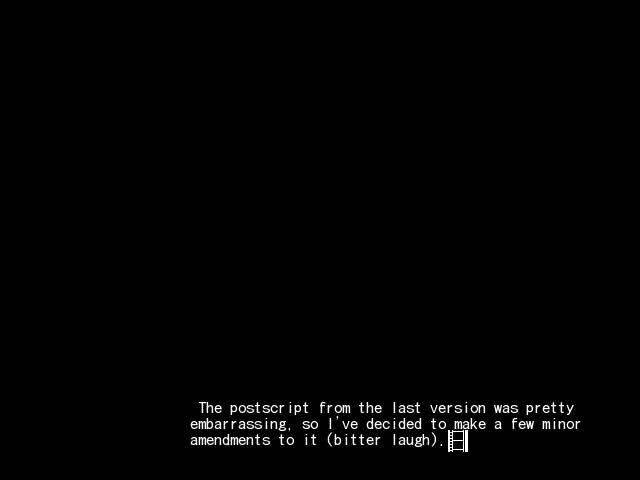
The postscript from the last version was pretty embarrassing, so I’ve decided to make a few minor amendments to it (bitter laugh).
Before continuing, note that this is a translation of the postscript in Aru Fuyu no Monogatari. While we had one example of an al|together game where the translator weighed in during the postscript (The Poor Little Bird), this postscript is clearly a translation of the Japanese original. With that being said – note the line “the last version.” Was there a prior version? What does this mean? I thought there was only one Aru Fuyu no Monogatari. Moreover, note that I am not sharing the entire postscript, some of it features comedy related to the game – I am focusing only on the parts related to there having been a previous version of Aru Fuyu no Monogatari.

So ‘postscriptor’, eh? …I sure came up with some childish material back then, didn’t I?
While we have a “back then” reference, I must highlight that calling the postscript Postscriptor is clever in light of the fact that Aru Fuyu no Monogatari was written in NScripter (the English version is written in ONScripter-EN).
After skipping some banter between the creator of the game and the characters, we find another reference to a previous version:
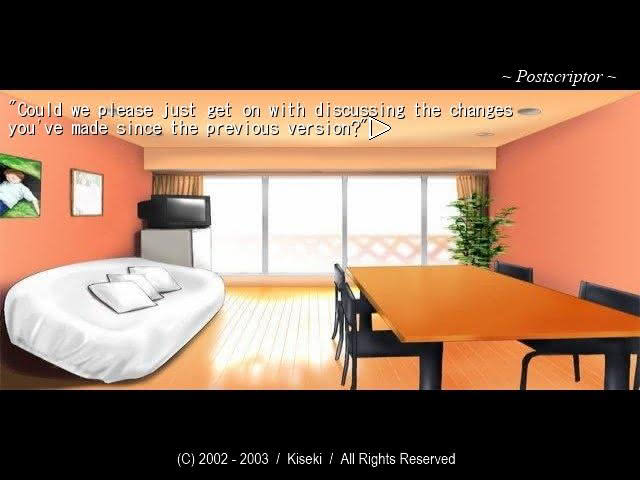
Then we learn what changed in the October 2003 version of Aru Fuyu no Monogatari from the original 2002 version:

- Changed the compression algorithm.
- Fixed up the postscript.
Well, at the very least, we can apparently rest assured that the 2003 version of the story was not meaningfully different than the original – save perhaps for the postscript. The characters of the story called out the creator for laziness:

Then, in an interesting point, we learn why the author decided to release a second, improved version of Aru Fuyu no Monogatari:
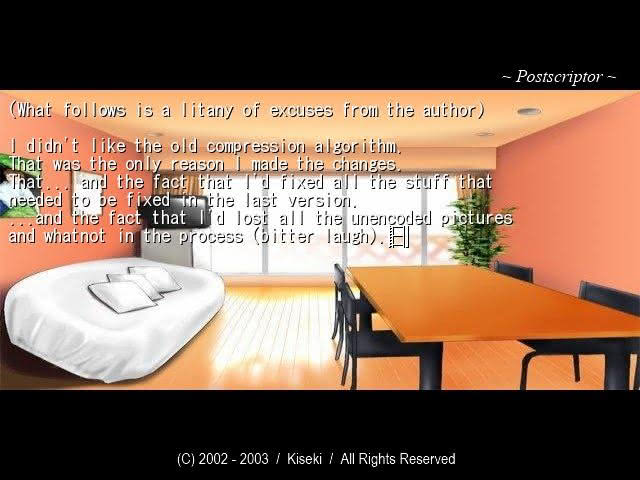
This is a bit difficult to read, so I will quote the author in full:
I didn’t like the old compression algorithm. That was the only reason I made the changes. That… and the fact I’d fixed all the stuff that needed to be fixed in the last version. …and the fact I’d lost all the unencoded pictures and whatnot in the process (bitter laugh).
The main reason for the “new” version of Aru Fuyu no Monogatari was entirely technical. That the author re-did the postscript seems like a while I was in the area I might as well move. In any event, there is no indication that the changes affected the story in any way. However, “last version” could be read as suggesting that the previous version was not the first version. When I originally wrote this paragraph, and when I reviewed the game, I had reason to be confident that only two versions of Aru no Fuyu Monogatari had been released. As it would turn out, I learned that my assumption was incorrect thanks to my doing more careful research to double-and-triple-check my work for this article. The use of last instead of first may, in fact, have been significant. But let us not get ahead of ourselves…
Finally, as I noted in the original piece, the original release of Aru Fuyu no Monogatari was apparently something of a success for a small indie project:
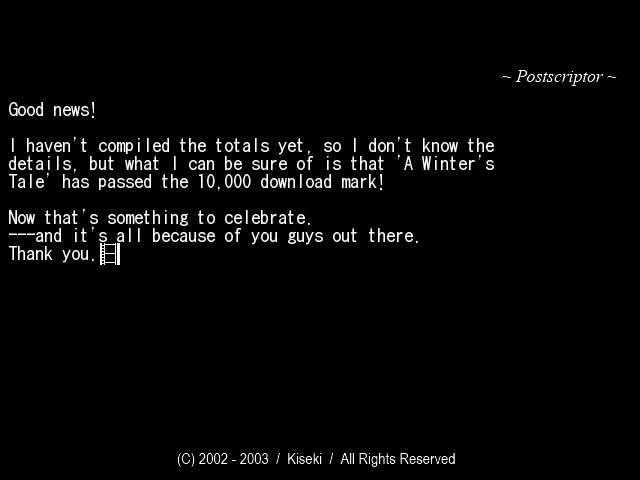
I wonder how many people downloaded the remastered version and were able to enjoy the new compression algorithm and postscript. From our evidence, it seems likely that more Japanese players played an earlier version of Aru Fuyu no Monogatari than the final translation that served as the base for A Winter’s Tale.
Finding the original Aru Fuyu no Monogatari
The postscript, which was expertly translated by a AstCd2, appears to establish clearly and beyond doubt that the October 3, 2003 version of Aru Fuyu no Monogatari was not the first released version of the visual novel. However, that in and of itself did not mean that I would be able to find the original, although I assume that many copies still exist in Japan based on the number of downloads reported by the developer in 2003.
The first issue, of course, is that materials related to the Japanese game would be in Japanese. While there are many translation tools available, these tools are imperfect and do not solve searching problems. The second issue is that most of the teams and developers behind the Japanese visual novels that were translated for al|together are no longer active, or if they are it is not in their original capacities. There are exceptions to the rule – notably milkcat, who is behind two of the al|together visual novels and is still producing games under the same label today – but most of the teams are long disbanded. In the case of Aru Fuyu no Monogatari, Visual Novel Database does not indicate that the developer, Endou Kenji, released any other projects under the same label.
The first thing I did was check the Visual Novel Database page for the October 3, 2003 release of Aru no Fuyu Monogatari. The page did not include a link to a website for the game – leading me to suspect that the reason was that the website was no more. Next, I decided to check the Visual Novel Database page for Endou Kenji. This page, unlike the page for Aru Fuyu no Monogatari, did include a link to an official website. However, as I suspected, the website only exists on the Internet Archive. The developer’s website was hosted on Vector, a Japanese website where people can upload files for download by others (available at vector.co.jp).
The Visual Novel Database link takes us to an August 11, 2003 capture of the website. This is, of course, prior to the October 3, 2003 release date of the game. It includes a link to Aru Fuyu no Monogatari (I used Google Translate to ID the link). That link took me to a December 7, 2003 capture of a download page for the Aru Fuyu. Now this download page postdates the most-recently known version of Aru Fuyu no Monogatari. I know the obvious way to find an earlier version (there are prior Internet Archive captures of the download page), but first let us confirm that the most recent version was released on October 3, 2003.
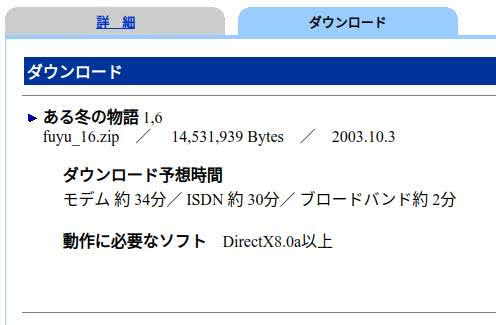
Sure enough, the fuyu_16.zip file is dated October 3, 2003, the date we would have expected.
Before finding an even earlier version of the game, I figured I may as well check to see if 2003 was the final version. While I was able to confirm that the game was listed on Vecor as late as November 2, 2007, the last capture of the actual download page is from June 23, 2004. The June 23, 2004 capture lists the October 3, 2003 release of the game, so I will assume that this is the definitive version of the Aru Fuyu.
I clicked around a bit and found the home page for the author of Aru Fuyu no Monogatari on the download site – specifically an August 4, 2004 capture thereof. Here, the team announced that they were freezing the site, adding further evidence to our assumption that the team’s only project was Aru Fuyu no Monogatari. However, the page included something even more interested, highlighted for your convenience below:

We have links to a “ver.1.6” and “ver.0.42”. A translator indicates that both links are for A Winter’s Story. Unfortunately, neither link can be followed in the Wayback Machine. But I ask you, the reader, to scroll up to my screenshot of the October 3, 2003 game to check the version number.
1.6.
Very good. So the 1.6 clearly does refer to the most-recent version of Aru no Fuyu Monogatari, and from the fact that the development team closed down its website in 2004, we should have no doubt that this was the final version of the game. When I first came across this information while writing this article, I thought that we had determined that there were only two releases of Aru Fuyu no Monogatari. However, as you will discover in the same series of steps that I discovered the truth, this turned out to not be the case.
I began working under the assumption that version 0.42 was a previous version of Aru Fuyu no Monogatari. Now, if you are able to read Japanese and you follow the relevant link and consult my screen capture, you may spot my error – an error that was not ameliorated by shaky machine translations of the text. Know that I actually wrote a good chunk of this article in error, only discovering my mistake after the fact and having to make adjustments while preserving my journey. Before continuing, I will state three things as red truths (visual novel fans will get the reference, but here is an aid for those of you who do not):
- Both versions 1.6 and 0.42 were created by the same developer
- There was more than one version of Aru Fuyu no Monogatari
- Version 0.42 was not a release of the Aru Fuyu no Monogatari visual novel
Going into the article, I knew that there was a December 29, 2002 version of Aru Fuyu no Monogatari. I had not previously noted the version numbers. Thus, I assumed that the December 2002 release was version 0.42. But in the interest of writing an interesting article, I decided to leave no stone un-turned.
I found the earliest version of the developer’s website in the Wayback Machine – December 16, 2002. The page describes Aru Fuyu no Monogatari and includes a link to a download page. Does this mean that the visual novel was released on or before December 16, 2002?
Here, I should have been suspicious given that I was only aware of a December 29, 2002 release – but I figured initially that the site pre-dated the game. I followed the download link, conveniently marked with our Latin alphabet letters DL for those of us who cannot read Japanese without help. We are taken to a page with information about the game and another download link, but no date.
This link brings us back close to where we started – the Vector download page for Aru Fuyu no Monogatari. As I noted at the top, I could have skipped many steps and jumped to a pre-October 3, 2003 capture of the page, but what fun would that have been? Moreover, we could have missed out on some valuable information by skipping steps. As luck would have it, following the download link from previous page brings us to the Wayback Machine’s a February 2, 2003 capture of the page. Astute readers will note this is before October 3, 2003. It also contains a download link. We just need to follow one more link…
Here, I had my first revelation of the current research project. I knew from before that the February 2, 2003 capture of the download page showed a version of Aru Fuyu no Monogatari that was released on December 29, 2002. However, I noticed that there was an even earlier capture of the page with the actual download link. This earlier capture was from December 17, 2002.
Uh-oh.
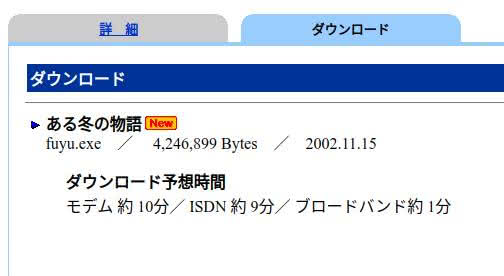
So, we have a download date for Aru Fuyu no Monogatari dated November 15, 2002. Moreover, this version does not have a version number. Also note the name of the executable download here – fuyu.exe.
While I have already spoiled that there is another version, let us show our work. The next Wayback Machine capture of the download page is from February 12, 2003. This is the capture that I relied on in my article. The Wayback Machine captured a shiny New tag next to the release, and this one is dated December 29, 2002.
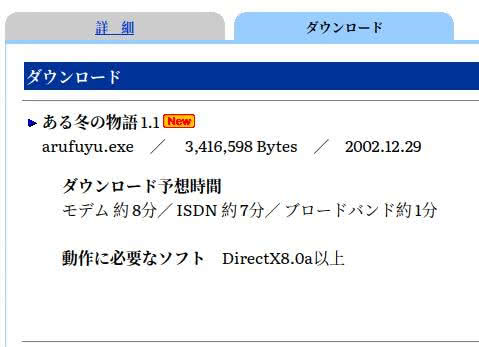
The executable’s name is different – it is now arufuyu.exe. However, another thing changed. This version has a version number. Surely the version number will be 0.42, just like what we saw on the website.
It is 1.1.
Well, that is interesting.
Now I have also already spoiled that I misinterpreted the meaning of version 0.42, but you can see that things are already becoming a bit more confusing.
The next Wayback Machine capture is from August 15, 2003. This time, we have an arufyuy16.exe file with a version number of 1.6 and a release date of May 24, 2003. Now the version number matches the final version, but the packaging format (exe instead of zip) and release dates are different.
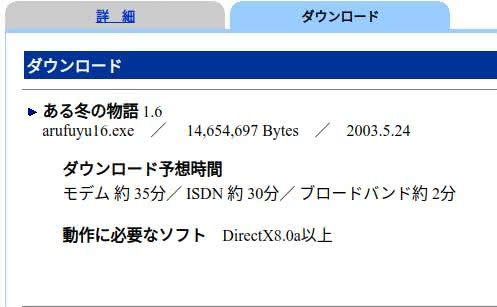
That is the final pre-October 2003 capture of the actual download page that we have.
What do we know so far? First, we know that there are at least four distinct releases of Aru Fuyu no Monogatari: Nov. 15, 2002 (no version no.); Dec. 29, 2002 (ver. 1.1); May 24, 2003 (ver. 1.6); October 3, 2003 (ver. 1.6). Moreover, we know with certainty that there were no releases after the October 3, 2003 version 1.6. We cannot say with absolute certainty that the November 15, 2002 release was the original release, but I have no reason to doubt that it was – especially with its lacking a version number. We can also be absolutely certain that the English A Winter’s Tale was translated from the October 3, 2003 version 1.6 and not the previous versions. Based on this, we know that the compression change noted in the postscript occurred between one of the earlier releases of the visual novel and the October 3, 2003 version 1.6.
What do we not know? At the moment, there is the mysterious version 0.42, which I was not sure about when I initially reached this point writing the article. We also cannot rule out additional versions of the game not captured in the Wayback Machine Archive, but this does not seem too important since we know what the final version is. Perhaps the most perplexing questions is why there were two releases of version 1.6 and what were the difference between them.
Although I spoiled that version 0.42 was not a release of the visual novel itself, it may still be relevant to our questions.
After clicking around a bit, I managed to navigate to the second game link connected to the author (from July 5, 2004 author profile page). When I first translated it, I assumed it must refer to Aru Fuyu, but with my suspicions having been raised, I read the poor machine translation more closely…
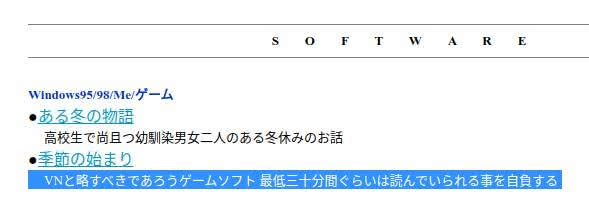
The 30 minutes should have been a tip-off. While Aru Fuyu no Monogatari is not a long visual novel, it should take most readers somewhere in the neighborhood of one hour. Moreover, I thought of another lead while doing final edits on this article (note that this is the last thing I wrote), the earliest capture of the author’s page from April 5, 2003 only lists Aru Fuyu no Monogatari. Whatever the mysterious second link is must have been added later…
I followed the second link to with the reference to 30 minutes. There are several captures of the page, but I opted for the earliest – from February 2, 2004.
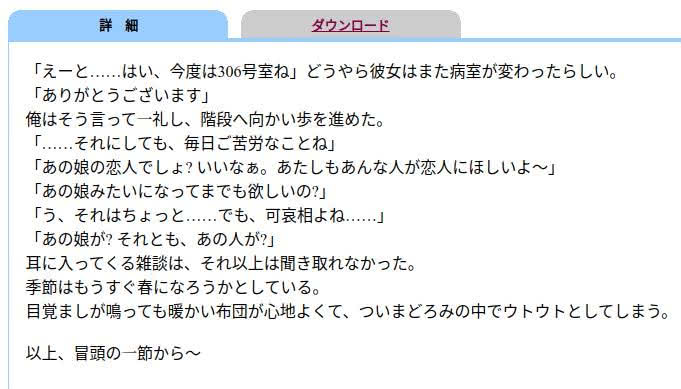
Before checking the actual file that was available for download, let us read the Google Translated version of the text:
“Um…yes, this time it’s room 306.” Apparently she’s changed rooms again. “thank you” After saying that, I bowed and walked towards the stairs. “… Even so, it’s hard work every day.” “You’re that girl’s lover, aren’t you? That’s great. I want someone like that as my lover.” “Do you want to be like that girl?” “Uh, that’s a bit… but it’s a pity…” “That girl? Or that person?” I couldn’t hear any more of the chatter that came into my ears. The season is about to turn into spring. Even when the alarm rings, the warm futon is so comfortable that I fall asleep in the slumber. From the beginning of the above
I had found this page previously, but I thought it could be related to Aru Fuyu or an early version thereof, attributing differences between this description and any events in Aru Fuyu to poor translations. Another thought that had occurred to me was that it was a file for the ending song of our visual novel, which has vocals. But I am inclined to doubt that as well too. But let us check the actual download page. There are only two captures of the actual download page, and the first is from June 18, 2004. Surely the download itself will have a similar date…
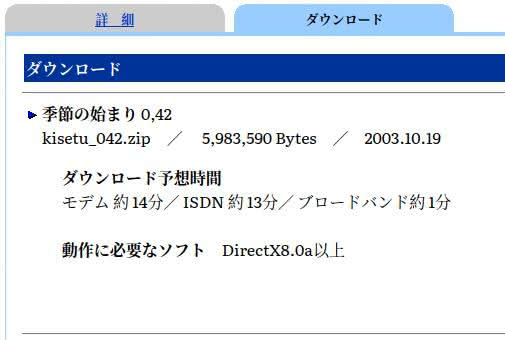
Well this is something. So this is a version 0.42, but for a file named kisetu. It is just over 1/3 of the size of the Aru Fuyu no Monogatari download. It is dated October 19, 2003 – meaning it was made available for download 16 days after the last version of Aru Fuyu no Monogatari. Could it be some sort of sound file? I think not. See the Google Translate-generated description from the author page:
Game software that should be abbreviated as VN I take pride in being able to read for at least 30 minutes
This certainly seems like a description for a game, not a sound file. Moreover, as I noted earlier, even a fast reader would be hard-pressed to read Aru Fuyu no Monogatari in 30 minutes, unless it somehow reads twice as fast in Japanese than in English.
Moreover, the description for what I know is Aru Fuyu describes the game perfectly. Below I share the Yandex translation of the text that goes with the Aru Fuyu no Monogatari downloads:
The story of a winter vacation with two childhood friends…
The differences between the known Aru Fuyu download descriptions and this Kisetu download are too much.
Finally, the download page for the mysterious version 0.42 of the kisetu.zip lists DirectX as a requirement – something that would not be true of an audio file.
But what is this version 0.42? I tried copying the Japanese title (the characters) into Visual Novel Database, but found nothing. I also tried translating the text from the farewell page of the development team to see how it reads:
The Beginning of the Season
My last idea was to check prior versions of the author’s former website – this time looking for Kisetu instead of Aru Fuyu. The closest capture to the shutdown was from October 3, 2003 (fitting…).
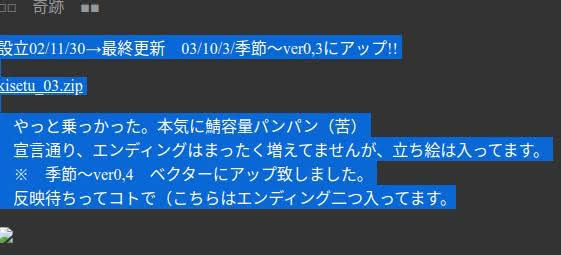
Unfortunately, both Google and Yandex make a hash out of this translation. But I will share two interesting lines from Google that seem notable:
“As promised, the number of endings has not increased at all, but there are standing pictures.”
And…
*Season-ver0,4 have been uploaded to the vector. “I’m waiting for it to be reflected (this one has two endings.
We can glean a bit from this. Firstly, the note itself is actually dated October 3, 2003. Thus, the first line relating to “the number of endings” is almost certainly about Aru Fuyu no Monogatari since we know from the postscript that the in-game content and story were not modified at all. Moreover, as I will discuss in a bit, this note seems to resolve the question we had about two versions 1.6.
Now in my screenshot, you will notice that there is a link to a kisetu_0.3.zip, which of course is different than the 0.42 version we saw before. However, read the comment carefully. The author states that version 0.4 had already been uploaded, but had not been reflected. This likely means the upload had to be approved – or something to that effect – before it would be available for public download. Even more interesting is the “this one has two endings” comment. This establishes clearly and beyond doubt that Kisetu is also a visual novel. At first I thought that I had only discovered a missing release of a particular visual novel in the Visual Novel Database. Instead I discover an unlisted visual novel.
Having come this far – already much further than I thought I would need to go when I started writing this article – I decided to see if we could find anything else about the Kisetu project. However, my run of good luck would end. The earlier versions of the developer’s homepage only reference Aru Fuyu. I was excited when I found a single working archived version of the developer’s “diary” (from August 25, 2003), but none of the entries deal with the game design work – they are all quips from daily life.
Having done my utmost to add to the world’s knowledge of obscure Japanese indie visual novels, I now move on to my conclusion.
Conclusion
I started writing this article to show how I found the first release date of Aru Fuyu no Monogatari. While writing the article, I discovered that there were more release dates, before discovering an entirely different game by the same team. This has been quite tiring, especially since I did this on the same day I wrote and published my actual review of the English-language version of Aru Fuyu, A Winter’s Tale. While I cannot definitively resolve every question that I ended up opening up through my research, I think we can resolve the big questions.
What was the first published version of Aru Fuyu no Monogatari?
I think that the first version of Aru Fuyu no Monogatari was the November 15, 2002 release that came without a version number. Evidence in favor is the fact that this was the first Wayback Machine capture of the download page and also that it is the only one of the four download files without a version number.
When the developer described changing the compression algorithm and the postscript in the postscript to the October 3, 2003 version of Aru Fuyu no Monogatari, what did he mean when he said the “last” version?
We can rule out the November 15, 2002 release since there were subsequent versions. The only two other releases we know of are the December 29, 2002 version 1.1 and the May 24, 2003 version 1.6. It is possible that there were more intervening releases, but we can neither confirm nor deny whether this is the case. I suppose the important question is whether the “changes” in the October 3, 2003 version were changes from the May version 1.6 or changes from a prior versioned release.
Based on the statement on the developer’s website on October 3, 2003, I think that the October version 1.6was changed from the May version 1.6. That is, I will venture that the May version 1.6 included the prior postscript and compression algorithm. Note the developer presented the October 3 release as a long-promised new version. This statement would have been worded differently had it just been a re-packaged version of the May 1.6. These conclusions are entirely consistent with the translated postscript to the October 3, 2003 version.
Thus, while I do not know why the May and October releases share a version number, I am fairly confident (as confident as I can be without confirmation) that they are different in more ways than file format.
What is Kisetu?
It seems clear from the evidence that Kisetu was a different visual novel project by the same team. We know for certain that a version 0.3 was published before version 0.42. We also know that version 0.42 was the final version based on the fact that the team folded its website in November 2003. However, it does not appear to be on the Visual Novel Database and even if it was later published under a different team, the name is too generic to pin down. From the description, we know that it takes place when winter turns into spring, that it has two endings, and that it takes about 30 minutes to read. I will note there are some similarities in the description between it and the completed A Winter’s Tale. I vaguely entertain the possibility that it could be some sort of sequel, but I think that it was most likely an entirely separate project – especially since there is no reference to it in the postscript to A Winter’s Tale.
Invitation
On the off-chance that we have any Japanese readers or readers who can read Japanese and may thus be able to find obscure, old, Japanese visual novels, let me know via our Contact Form if you have any additional information about the versions of Aru Fuyu no Monogatari or the still-mysterious Kisetu visual novel project. I would be interested in following up on this article in the event that more information becomes available. Additionally, if anyone happens to have a copy of Kisetu, I would be very interested in seeing it and running it with the aid of compatibility tools.
In the interim, I encourage you to read my review of A Winter’s Tale and try the game for yourself. While it plays things safe, it is a good read and one of the better visual novels of the al|together collection.
February 21, 2023 update: I capped off this research piece with a post on an original gif ad for The Legend of Heroes: Trails in the Sky that I found while researching.